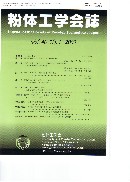All issues

Volume 46, Issue 1
Displaying 1-5 of 5 articles from this issue
- |<
- <
- 1
- >
- >|
Original Paper
-
Mitsuru Egashira, Takeshi Konno, Mikihiko Kobayashi2009 Volume 46 Issue 1 Pages 4-12
Published: January 10, 2009
Released on J-STAGE: October 20, 2009
JOURNAL FREE ACCESSNickel particles of several tens μm were welded to a gold substrate by contact discharge welding and the joints were strengthened by non-contact discharge welding under various conditions. They can be welded at the same condition that the gold particles were welded, as described in our previous paper. The non-contact discharge welding was carried out in N2 gas flow, in Ar gas flow and in He gas flow. The fracture load of the joints welded in N2 gas flow were higher than those welded in Ar or He gas flow, though cracks were observed in some samples. Preheating of N2 gas and substrate were effective to suppress the generation of cracks to some degree. The fracture stress of the joint was about one sixth of base nickel, because of oxidation during welding.View full abstractDownload PDF (1948K) -
Hisanori Yokoyama, Hideaki Tsuge, Seizo Obata, Masayoshi Kamai, Hiroya ...2009 Volume 46 Issue 1 Pages 13-19
Published: January 10, 2009
Released on J-STAGE: October 20, 2009
JOURNAL FREE ACCESSOptimization of slurry for nozzle-free ink-jet forming was investigated. 10 mass% aqueous slurry of colloidal silica was prepared, and the effect of slurry properties on the droplet formation process and the printed characters was examined. The surface tension and apparent viscosity of the slurries had the influence on the droplet formation and the printed dot diameter, and the dot diameter decreased as the viscosity increased. Using the slurry with the phosphor powder (mean particle size : 1.8μm), clear patterns were obtained by the nozzle-free ink-jet forming.View full abstractDownload PDF (829K) -
Ikuko Yamada, Shoichi Kume, Yuji Hotta, Koji Watari2009 Volume 46 Issue 1 Pages 20-24
Published: January 10, 2009
Released on J-STAGE: October 20, 2009
JOURNAL FREE ACCESSThermal effusivity and conductivity of sintered alumina filler at the micrometer-scale have been measured by a thermal microscope. Those of sintered alumina have also been measured for the purpose of comparison. The thermal effusivity ranged from 4.31 to 11.36 kJ·s-0.5m-2K-1 and the calculated thermal conductivity varied from 6.2 W·m-1K-1 to 42.7 W·m-1K-1. This result indicates that alumina fillers have wide ranges of thermal conductivity at the micrometer-scale.
On the other hand, the variation of thermal conductivity of alumina fillers was in good agreement with that of the sintered alumina. The maximum and minimum values of thermal conductivity of sintered alumina appeared at a dense and a porous area, respectively. On the basis of the data for sintered alumina, the variation of thermal conductivity of filler are greatly affected by the microstructure.View full abstractDownload PDF (754K)
Review
-
Hiroyuki ShintoArticle type: Review
2009 Volume 46 Issue 1 Pages 25-34
Published: January 10, 2009
Released on J-STAGE: July 17, 2020
JOURNAL RESTRICTED ACCESSDownload PDF (12294K)
Review: Frontier Research Series
-
Yuichi TozukaArticle type: Review: Frontier Research Series
2009 Volume 46 Issue 1 Pages 35-39
Published: January 10, 2009
Released on J-STAGE: July 17, 2020
JOURNAL RESTRICTED ACCESSDownload PDF (6697K)
- |<
- <
- 1
- >
- >|